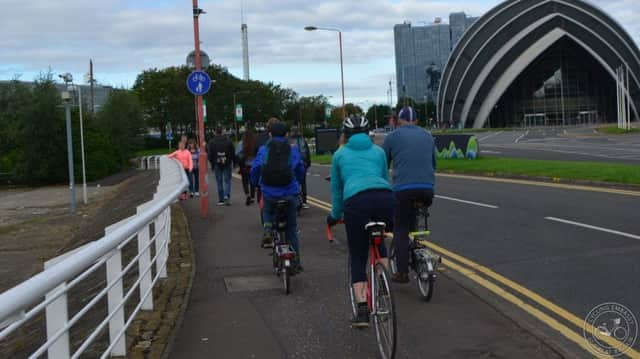Alastair Dalton: Cyclists and pedestrians need help learning to share space


It seems that for every jaywalker ambling across the road, there is also someone pedalling on the pavement, taking a shortcut or avoiding a one-way street to the irritation or danger of walkers.
But things are becoming more complicated than each just keeping to their own space - cyclists on the road and walkers off it.
Advertisement
Hide AdAdvertisement
Hide AdAs moves to encourage more people to cycle gather momentum, routes are being developed to take those on bikes away from other traffic, to make them feel safer and embolden the timid.
While the latest of these routes will provide separate lanes for cyclists and walkers, the rest of Scotland’s extensive off-road path network is largely shared space, without even dividing lines.
Part of the problem is that some of these are not clearly marked to show their purpose. There can be a distinct lack of the circular blue and white signs containing cycle and pedestrian symbols. I reckon that if at any point a pedestrian were to challenge a cyclist about being on such “pavements”, a sign should be visible to them for the cyclist to point out.
That’s crucial because many of these routes look just like other pavements, making law-abiding cyclists as self-conscious as pedestrians are oblivious while using them.
Advertisement
Hide AdAdvertisement
Hide AdAt best, it’s a matter of etiquette, and even that can be tricky. Sound your bell and a walker might welcome it as a helpful warning that avoids them being startled as you ride by. But equally, it could interpreted by others as an impatient demand to move out of the way.
One woman even once turned round and haughtily told me: “Yes, we know you’re there”.
However, at worst, there is the potential for serious injury when cyclists and pedestrians collide, as footage of several incidents posted online has demonstrated.
If cycling increases, the risk is likely to rise. Just as the current focus is on segregating cyclists from cars and other vehicles, there may yet become a need to separate cyclists and pedestrians too.
Advertisement
Hide AdAdvertisement
Hide AdUntil then, as I’ve argued before, off-road paths used by cyclists must be far better marked.
Cycle lanes on pavements should be a uniform colour - not the red, green or whatever hue individual Scottish cities have confusingly chosen for themselves.
Paths should also be coloured continuously over their entire length, not just at intermittent points like junctions. That would help it make things clear to everyone.
On shared paths, the need for clear, consistent and frequent marking is even greater. Pedestrians are justifiably angry to find cyclists on pavements, but understand and would be on the lookout for them where there are highly-visible signs on shared paths.
Advertisement
Hide AdAdvertisement
Hide AdThis is particularly important on busy, narrow sections. An example is near the Hydro arena beside the Clyde in Glasgow, which is thronged with hotel guests and people heading for events.
In the meantime, everyone will need reminding how to behave. There are bad drivers, bad cyclists and bad pedestrians. Like the drivers who intimidate people crossing the road by accelerating towards them, the cyclists who crash into other cyclists on unlit paths “because they don’t have to have lights off road”, and the pedestrians who saunter across the road in front of traffic as if they owned it.